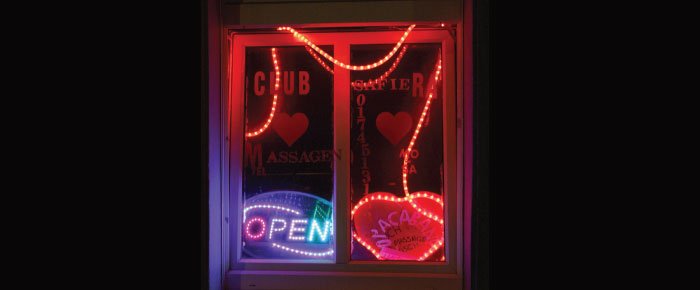
I vividly recall my reaction to hearing about human trafficking several years ago. It was a combination of disbelief, anger and disgust. The sheer reach of this crime made the problem seem overwhelming as there are so many different variables to identify and address: Is sex or labor trafficking, and is it global or domestic? I asked myself how, as a bank anti-money laundering (AML) compliance officer could I identify traffickers during the account opening process or through transaction monitoring? I wondered how could I make a positive impact on helping fight this appalling crime?
Breaking Free has become one of the nation's leading organizations in working with victims
I resolved to increase my awareness of this issue and better educate myself by reading everything I could find, watching movies and documentaries and subscribing to news feeds and Google alerts related to this topic While this initial information provided a solid foundation of understanding, I was now hungry for more knowledge. I wanted to add a personal level of engagement to my education, so my next step was to volunteer with two different organizations: Not For Sale (NFS) and Breaking Free.
NFS works to ensure that no one is for sale. NFS creates enterprise opportunities for vulnerable communities, offers social services to survivors and those at risk to human trafficking and evaluates the use of forced labor in mainstream supply chains (to find out more about NFS's work, go to: http://www.notforsalecampaign.org).
Breaking Free is a nonprofit agency helping women and girls escape systems of prostitution and sexual exploitation through advocacy, direct services, housing and education. Breaking Free has become one of the nation's leading organizations in working with victims and survivors of sex trafficking and prostitution. Founder Vednita Carter has spoken to the United Nations twice on the issue of domestic trafficking, and participated on President Obama's human trafficking committee (for more information on Breaking Free, go to: http://www.breakingfree.net).
The webinars, forums, books, documentaries and local volunteer work paint an incomplete picture and do not fully prepare you to combat human trafficking. To complete this picture, I joined a faith-based women's group on a trip to Bangkok's red light district to support two groups that work with rescue and recovery efforts in the sex tourism industry. I am sharing my perspective and experiences from a ten-day trip to Bangkok.
I knew I would be out of my comfort zone and stretched with new experiences. After a 30-hour flight, my mission began with reading a sign posted at the immigration counter that warned readers of the risk of human trafficking. Two of the three languages on this form were not English and used characters instead of letters. The message said: "Do not believe advertisements for well-paying and simplistic jobs, and do not believe strangers with job offers."
This was just the beginning of ten days of a considerably steep learning curve. Bangkok is crowded and busy, even at 2 a.m. Narrow streets lined with vendors and Volkswagen buses made into mobile bars, cars, tourist buses, and motorcycles — people everywhere! I was in sensory overload with all of the noises, unfamiliar smells, food I couldn't recognize, billboards and street signs I couldn't read, a language I couldn't understand and I had no idea where we were. I was starting to relate to trafficking victims being stripped of anything familiar for intimidation and control.
My first experience walking through one of the Red Light Districts brought the facts I had read about to a painful reality. We saw a street with bars facing each other and open patios with neon lighting and bikini-clad girls to entice customers. Each bar had a different theme and costumes to match, but some things remained consistent. These girls all looked young, were wearing outfits that left little to nothing to the imagination, were heavily made up and smiled to entice passersby into the bar and club where the dancers performed. Patrons picked the girls by the number they wore, negotiating the price with the bar's "mamasan," a female bar manager. The prices usually ranged from about $30 for a few hours or $95 for the night. To the patrons and owners, these girls were a number with a dollar sign and not a person.
Our group of eight broke up into smaller groups and entered separate bars with the intention of talking with the girls. We did this under the guise of giving free manicures. Several bars would not let us enter but, for reasons unknown, we were welcomed in others. When we purchased drinks, the girls received tickets. We were told that each drink purchased, dance performed or service provided resulted in tickets. Tickets were turned in at the end of each night to the owner and the girls would be paid minus their expenses.
Many of the girls were very willing to talk with us. The younger ones were more eager to tell their story. I learned that Thai culture encourages the men in the families to join the monastery and become monks. There is no money earned for these years of training. The financial burden of the family is often assigned to the women and daughters. The youngest girl I met was eight years old. Her family was depending on her to earn enough for surgery and medical bills of the grandmother and to cover the finances of the family coffee farm in the northern part of the country. Families resorted to putting young girls to work to avoid the loss of land that had been in their family for generations.
Another common story was that the girls were searching for an American boyfriend or husband to save them from the poverty lifestyle. This solution has been known to have dire consequences for some. We were told of instances where the girls fell in love and married an "American." The new husband would take out a life insurance policy on his new bride and, after an appropriate amount of time to give the appearance of being the happy couple, the bride would suffer a terrible accident and be found dead. The husband was often the sole beneficiary, although we heard variations of the story where the bride's family would get a percentage of the insurance claim as co-beneficiary or receive money directly from the husband.
One night, three of us were allowed into a bar in Soi Cowboy, one of the many bars in the Red Light District. We first purchased our drinks, bottled water with no ice and opened our Rubbermaid totes with manicure supplies. The stern-faced mamasan approached me with a piercing stare. I paused, remembered to breathe and waited for her to speak. She gruffly said several sentences to me, which translated to: "I'm the mamasan. You do me first, and I will choose color. If you're good, then your friends can do the girls." I knew she was trying to intimidate me, so I smiled and showed her the best nail polish we had and she proceeded to choose her color.
We shared a smile, and she started to laugh, motioning to the other girls to start lining up for manicures. The stories flowed; everyone was giggling, and the girls were happy to show off their painted nails. We had girls standing in line two or three deep. This went on for almost two hours before the bar owner angrily approached the mamasan who was still sitting next to me. Words were exchanged in rapid fire with arms and hands flying to emphasize their points. The faces on the girls turned quickly somber then to stage smiles. We didn't need our translator to tell us that we needed to pack up and leave.
As we were hurried out to the street, the mamasan told us we could "come back at 4 p.m. tomorrow, before business starts." Unfortunately, our schedule wouldn't allow that. Was this an insight to the anger and control these girls experienced every day? Instead of creating memories with childhood friends and families, their nights were spent with men the age of their fathers and grandfathers. The use of drugs and alcohol to numb the pain would never completely mask the physical abuse, sexually transmitted diseases, and oppression now prevalent in their lives. Teenage years that should be exciting and anticipating the future, now appear to be stagnant with domination and a grim outlook.
The groups working to rescue the girls in Bangkok confirmed that the majority of girls determined this is the only way they can earn money and provide for their families. Most of the girls were from Thailand, but an estimated 15 - 20 percent are trafficked from other countries. Programs exist to rescue these women, give them medical attention, arrange for micro-business training and support in their home countries. On-going support is provided for them once they return home for the length and scope of the transition process.
The majority of girls determined this is the only way they can earn money and provide for their families
We needed a break from the emotional storms we were experiencing. A Thai foot massage seemed like the perfect way to calm this turmoil in my heart. We chose a place that looked clean and the girls wore uniforms that resembled flight attendant pant suits. For me, it was as if each pressure point she massaged drained me of the pain and heartbreak we had been seeing at night. I thought we had found a small island in Bangkok where we were removed from the sex industry. When my massage was over, I went to the counter to pay. As I was waiting, I noticed a three-ring binder. I started flipping through the laminated pages, and felt my heart drop. Each page was a picture of massages and additional services for the back rooms. There seemed to be no escape from what the Thai culture accepts so freely.
What I understand better now is that this is not an easy crime to define. Each culture, country, state, law enforcement agency, healthcare organization, and individual can alter the approach to rescue, recovery and prosecution. I thought this trip was going to be the final piece of the puzzle, but now I realize there are many more pieces to complete this picture, and it needs to be finished and not put back on the shelf just because it's too challenging. As AML professionals, are we willing to review our transaction queries for multiple cash deposits from non-account owners, interstate transactions, travel patterns, or that identity theft may be the obvious offense for the bigger crime of trafficking? Are we able to benefit from strengthening relationships with law enforcement and rescue efforts? Would multi sector task forces in our communities profit from including the AML financial professionals? Can you bring to the table your passions, skills and experience and work collectively on completing this puzzle?
Sande Bayer, CAMS, V.P. corporate AML compliance, U.S. Bank, Minneapolis, MN, USA, Sandra.bayer@usbank.com.










